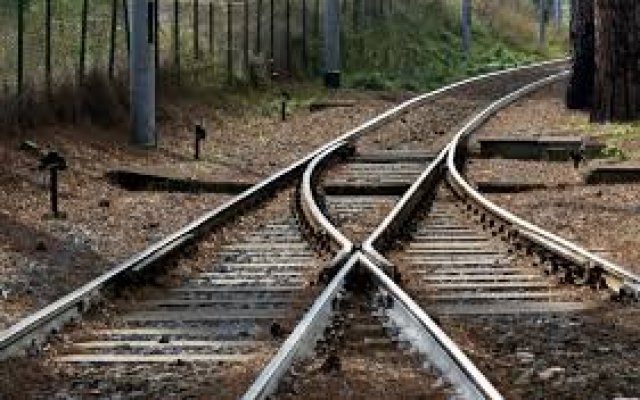
On a sweltering Kenyan morning on the outskirts of a national wildlife park, Chinese and local workers maneuver a massive concrete rail-bridge structure onto towering support piers. In the distance, trucks loaded with shipping containers rumble down a highway.
The bridge at Voi, northwest of the port of Mombasa, is the latest construction frontline for the initial 327 billion-shilling ($3.2 billion) stretch of an ambitious railway project to link the East African country with landlocked neighbors including Rwanda and Uganda. As a faster alternative to the trucks clogging the only road running inland to the capital, the Chinese-built and -financed standard-gauge railway, known as the SGR, has the potential to transform trade in the region.
Kenya’s rail line, the country’s biggest investment since independence in 1963, is among the most advanced of the more than $30 billion of African rail projects planned or under way. Together, they span more than 11,000 kilometers (6,835 miles), enough to connect Cape Town to Copenhagen. It’s one of the bright spots on the world’s least developed continent, where governments are wrestling with drought-induced food shortages, weakened currencies and shrinking budgets following the plunge in commodity prices.
Held Back
“Infrastructure constraints are one of the major things holding back Africa and this standard-gauge railway will make a big difference,” said Mark Bohlund, an Africa and Middle East economist with Bloomberg Intelligence.
Not all the projects will be built on time, if at all, especially with the commodity-price slump weighing on those designed to move raw materials from mines to ports. And with Chinese growth slowing, the nation’s central role in African infrastructure development may diminish. Countries including Kenya and Ethiopia are also borrowing heavily to fund projects.
Already, though, U.S. and European and companies such as General Electric Co., Alstom SA and LafargeHolcim Ltd. are poised to benefit, along with Chinese builders and African suppliers such as Transnet SOC Ltd. GE is investigating opportunities in countries including Kenya, Ethiopia and Nigeria and will have almost tripled its number of service personnel on the continent from 2015 to the end of this year.
West Africa
“The overall bed of opportunities around the region remains strong, at least 50 percent higher than it was 10 years ago,’’ said Thomas Konditi, GE’s head of transportation for Africa. “Those opportunities are still going to be strong for another five to 10 years.”
Besides the East African line, others on the continent include Bollore SA’s plan to develop a 2,700-kilometer West African rail corridor. The project, which has faced legal challenges from rival developers, would link Ivory Coast, Burkina Faso, Niger and Benin.
Also in West Africa, Senegal signed an agreement in December with China Railway Construction for the renovation of 645 kilometers of railroads. Projects are also planned in Tanzania, Mali and Egypt, while Ethiopia recently completed a line connecting Addis Ababa to Djibouti and has another 4,000 kilometers of projects planned.
Economic Growth
Rail infrastructure is vital to improve trade between African countries, which stood at just 13 percent of the total last year,according to the African Union.
Kenya, which moves about five percent of freight by rail, predicts the new project will add to economic growth. The government sealed agreements in March with Chinese partners to build the rest of the track up to the border with Uganda, which itself has signed construction agreements for the first phase.
Kenya’s initial stretch, from Mombasa to Nairobi, will be ready to start operating by June 2017, Kenya Railways Corp. Managing Director Atanas Maina said in an interview at the Voi bridge. The line will have daily capacity for eight freight trains in each direction, each with the ability to carry the equivalent of more than 100 containers. It’ll also run as many as two daily passenger trains each way.
Colonial Tracks
Besides the often-clotted Mombasa-Nairobi road, the only other land transportation option is the century-old railway completed by the British colonial authorities in 1901. The line operates at a leisurely pace of about 30 kilometers per hour, compared with 120 kilometers per hour for passengers and 80 kilometers per hour for freight that Kenya Railways is predicting for the SGR.
The railway design also accounts for local wildlife movements, said Kenya Railways social environmentalist James Chimera. Kenya Wildlife Service provided locations of animal-crossing corridors so elevated overpasses could allow elephants and giraffes to pass through safely, he said.
The Export-Import Bank of China has agreed to fund 90 percent and 85 percent respectively of the first two phases of Kenya’s project, with the government covering the rest.
Chinese History
China has a history of successful railway projects in Africa. The 1,870-kilometer Tazara railway, which linked landlocked Zambia to Tanzania’s Dar es Salaam port, was funded and built by China in the 1970s. Nigerian President Muhammadu Buhari plans to visit China to get funding for railway projects, Vice President Yemi Osinbajo said this week.
Some African mine-related freight rail and port projects have been delayed because of low commodity prices and there has been evidence of a shift towards investing in passenger rail instead, said Maria Leenen, CEO at Hamburg-based transportation consultancy SCI Verkehr.
Transnet, the South African rail and port operator marketing its train equipment and expertise across the continent as well as investing in rail at home, has seen pressure on its order book from the decline in commodity prices. However, the company continues to see opportunities, according to the head of its engineering and manufacturing unit Thamsanqa Jiyane. Contracts the company is working on include supplying wagons to Swaziland and passenger coaches to Botswana.
For some African governments, the tougher economic conditions are requiring more imagination for funding rail investments, GE’s Konditi said.
“I’m seeing more interest in creative financing — leasing — and I’ve seen more interest in letting the private sector drive some of the maintenance and service of the rail companies,” he said. “This environment is actually helping people to see things more creatively, in a very modern way.”
Source: Bloomberg


























